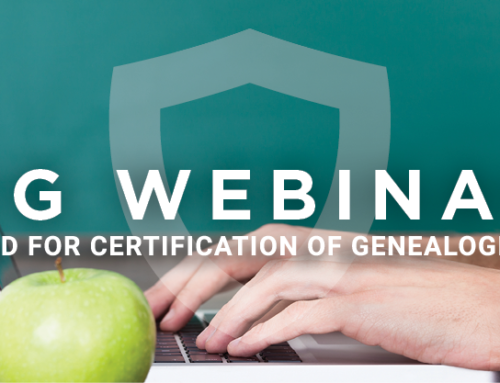Board for Certification of Genealogists Adopts Standards for DNA Evidence
On 21 October 2018, the Board for the Certification of Genealogists (BCG) approved five modified and seven new standards relating to the use of DNA evidence in genealogical work. BCG also updated the Genealogist’s Code to address the protection of people who provide DNA samples.
The new measures are intended to assist the millions of family historians who now turn to genetic sources to establish kinships. The action followed a public comment period on proposed standards released by BCG earlier this year.
“BCG firmly believes the standards must evolve to incorporate this new type of evidence,” according to BCG President Richard G. Sayre. “Associates, applicants, and the public should know BCG respects DNA evidence. It respects the complexity of the evidence and the corresponding need for professional standards. BCG does not expect use of DNA to be demonstrated in every application for certification. However, all genealogists, including applicants, need to make sound decisions about when DNA can or should be used, and any work products that incorporate it should meet the new standards and ethical provisions.”
“Standards for Using DNA Evidence,” a new chapter to be incorporated in Genealogy Standards, introduces the issues this way:
“Meeting the Genealogical Proof Standard requires using all available and relevant types of evidence. DNA evidence both differs from and shares commonalities with documentary evidence. Like other types of evidence, DNA evidence is not always available, relevant, or usable for a specific problem, is not used alone, and involves planning, analyzing, drawing conclusions, and reporting. Unlike other types of evidence, DNA evidence usually comes from people now living.”
In brief[1], the new standards address seven areas:
• Planning DNA tests. The first genetic standard describes the qualities of an effective plan for DNA testing including types of tests, testing companies, and analytical tools. It also calls for selecting the individuals based on their DNA’s potential to answer a research question.
• Analyzing DNA test results. The second genetic standard covers factors that might impact a genetic relationship conclusion, including analysis of pedigrees, documentary research, chromosomal segments, and mutations, markers or regions; also, composition of selected comparative test takers and genetic groups.
• Extent of DNA evidence. The third genetic standard describes the qualities needed for sufficiently extensive DNA data.
• Sufficient verifiable data. The fourth genetic standard addresses the verifiability of data used to support conclusions.
• Integrating DNA and documentary evidence. The fifth genetic standard calls for a combination of DNA and documentary evidence to support a conclusion about a genetic relationship. It also calls for analysis of all types of evidence.
• Conclusions about genetic relationships. The sixth genetic standard defines the parameters of a genetic relationship and the need for accurate representation of genealogical conclusions.
• Respect for privacy rights. The seventh genetic standard describes the parameters of informed consent.
The modifications made to several existing standards call for:
• Documentation of sources for each parent-child link.
• Where appropriate, distinction among adoptive, foster, genetic, step, and other kinds of familial relationships.
• Use of graphics as aids, for example: genealogical charts and diagrams to depict proved or hypothesized relationships; or lists and tables to facilitate correlation of data and demonstrate patterns or conflicts in evidence.
• Explanations of deficiencies when research is insufficient to reach a conclusion.
A new edition of Genealogy Standards is expected to be ready by next March. A new application guide and judging rubrics incorporating the new standards will be released at about the same time. In the interim, portfolios submitted for consideration for certification will be evaluated using the existing Genealogy Standards.
[1] The Board for Certification of Genealogists® (BCG) contractually granted the publisher of Genealogy Standards the exclusive right to copy, publish and distribute the standards including amendments. However, BCG-certified associates have the contractual right to include reasonable portions of the standards in presentations, articles, blog posts, social media, and the like. In no case may BCG or its associates allow the standards to be published in their entirety because the publisher deems that competitive to its publication rights.
The words Certified Genealogist and the designation CG are registered certification marks and the designations Certified Genealogical Lecturer and CGL are service marks of the Board for Certification of Genealogists, used under license by board-certified associates after periodic competency evaluations, and the board name is registered in the U.S. Patent & Trademark Office.


